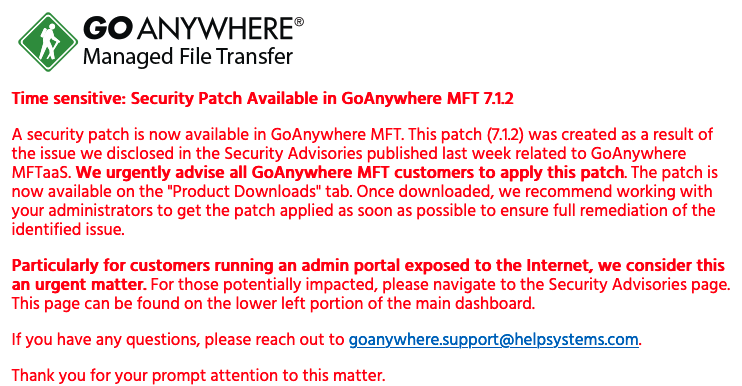A patch has been released for the GoAnywhere managed file transfer (MFT) software zero-day vulnerability whose existence came to light recently. News of active exploitation emerged roughly a week ago, but details about the attacks are still not available.
Fortra, known until recently as HelpSystems, alerted GoAnywhere MFT users on February 1 about a ‘zero-day remote code injection exploit’. The company has since released two other security notifications, each of them providing mitigations and indicators of compromise (IoCs).
GoAnywhere users are now being informed that a patch has been made available. Users are advised to urgently install GoAnywhere MFT 7.1.2.
“Particularly for customers running an admin portal exposed to the Internet, we consider this an urgent matter,” the company said.

There does not appear to be any information about the attacks exploiting the vulnerability. It’s unclear if it has been leveraged by state-sponsored threat actors or profit-driven cybercriminals.
A CVE identifier has yet to be assigned to the flaw.
Users have been told to check log files for a particular line that indicates a system has been targeted in an attack exploiting the zero-day vulnerability. If the log files show signs of compromise, users should check their installation for suspicious administrator users.
A researcher has published technical details on the flaw, as well as a proof-of-concept (PoC) exploit.
A Shodan search shows nearly 1,000 internet-exposed instances of GoAnywhere. However, the vendor pointed out that exploitation requires access to the application’s admin console, and at least some of the exposed instances appear to be associated with the product’s web client interface, which is not affected.
Related: Zero-Day Vulnerability Exploited to Hack Over 1,000 Zimbra Email Servers
Related: US Agencies Warn of APTs Exploiting Recent ADSelfService Plus Zero-Day
Related: Accellion Failed to Notify Customers of FTA Zero-Day














